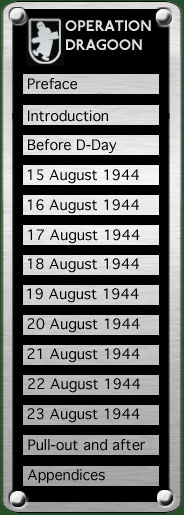
|
||
With the German position in Normandy collapsing, orders were given that the Nineteenth Army should withdraw north before it was cut off from friendly forces in Northern France and from Germany itself. One of DRAGOON’s aims had been to pin down forces in the South, so they could not reinforce the defence of Normandy but within four days of the landings this had become superfluous. The withdrawal order was intercepted and swiftly deciphered. The Luftwaffe was pulling out too. At Lajasse the Platzkommando was to withdraw after completing destruction of the landing field, runways, installations and any bombs and equipment which could not be transported away. In the woods northwest of Marseille, Major Wenze, CO of 536. Heavy Flak Abteilung, ordered all his unit's radar gear blown up. Jafü Südfrankreich was transferring his HQ to Metz and JGr. 200 was also meant to move there. By the morning of the 19th, 18 aircraft of I./KG 26 had landed at Lyon-Bron and a chateau had been requisitioned for the Geschwaderstab. At 11.00 hours the Gruppe was reporting (with reference to the previous night?) that no operation had been possible because there was no assisted take-off gear or torpedoes on the airfield. The crews themselves were too tired to transfer to an advanced landing ground, having had no rest in the last few days. Lyon-Bron also signalled 1.(F)/33 to send a crew to collect a Ju 88, 8H+LH. The Arado 196s of2./SAGr. 128 were ordered to the same destination by way of Lyon. Signed IA Ops, stamped 0820 [GMT]/19/8: Second/128 will transfer immediately with all its elements to Friedrichshafen. Flying elements will go via Lyon and ground elements by road. Report dispatch.
The ground elements of the "Divisional Staff" (presumably of Fl.Div. 2) were trying to move up the Rhône Valley from Valence but at 03.00 hours signalled II./KG 26 that they were held up fighting "terrorists" on the northern edge of Châteaubourg (8 km. south of Tournon sur Rhône). The sender called for help at dawn from two lorries with arms and rations and 80–100 men. At 09.30 hours a signal asked when the lorries had been dispatched and called for urgent urgent help. The Germans had not entirely given up however. At 08.10, three of JGr. 200's Bf 109s took off to make WGr. 21 mortar attacks on guerillas in the Vallon area, one of their number being posted missing, and half an hour later the Y-Service heard an enemy patrol reporting Allied aircraft in Rhône Valley area. Twelve Bf 109s of II./JG 77 reconnoitred along the coast and may well have been the aircraft encountered north of the beach head by P-47s of the USAAF's 86th Fighter Bomber Group at 09.15. JG 77 had sent another Schwarm at midday on a reconnaissance between Digne and Grasse but they broke off in the face of Allied fighters. Army Group G noted that the day’s reconnaissance had yielded no results. During the day Allied carrier-borne aircraft claimed 5-0-1 enemy bombers (the USN Official History speaks of a Do 217, an He 111 and three Ju 88s destroyed) and casualties were reported by KG 26: five NCO's killed from the I. Gruppe; nine dead, two wounded, another wounded and taken prisoner. It is not however clear which of these claims were in the air and which on the ground. However Obgefr. Friedrich Emde of 5./KG 26 was killed when his aircraft was shot down by a fighter 10 km south of Lyon There was some early evening activity when radio monitors heard tactical reconnaissance aircraft off Cap Corse and a lone Bf 109 was sighted but not engaged just east of Teyran. An order was intercepted (believed to be from 2. Fl.Div. to KG 77) for a twilight operation that night "with all forces" against the same target area as on the 17th. At 20.43 hours, a single aircraft approached CAMEL Beach at 1,500-2,000 ft. and dropped a stick of seven or eight anti-personnel bombs in the vicinity of four vessels in the inner screen. The bombs exploded 20 ft. above the water without causing damage or casualties. Shortly afterward USS Brooklyn tracked two groups of aircraft searching the area for about an hour but at no time did they come within 10 miles of Allied night fighters. At 19.55, a Hptm. Grohne phoned through the Air Liaison Officer’s report to Army Group G, including the following reconnaissance sightings: “This morning between 02.00 and 03.00 hrs. two convoys heading north in the sea area south of Toulon. 11.15 hrs south of Marseille, many ships.” During the evening, Stab KG 26, ground personnel and elements of the II. Gruppe arrived in Lyon from Valence to join I./26; the information was given out that Fl.Div. 2 was transferring to Lyon and Jafü Süd had now arrived in Metz. It seems also that some aircraft of II./JG 77 may have left France during the day since 5. Staffel's Uffz. Helmut Oettel (Bf 109 G-6, W.Nr. 163210 “black 3”) crashed and was killed SSW of Pavia, Italy. According to German ground troops, the aircraft was destroyed in an attempted emergency landing. continued on next page …
|
|||

